The economic impact of low back pain (LBP) is greater than $100 billion per year and causes more disability globally than any other condition (1,2). It is the most common cause of activity limitation in adults aged 45 and younger and only second to arthritis in people aged 45 to 65 (3). Of those who suffer an episode of LBP, approximately 50% will experience a recurrence with one year, 60% by year two and 70% by year five (4).
Given this economic and societal burden, a considerable amount of effort has gone into understanding the cause, treatment and prevention of this global problem.
There are multiple risk factors that can cause LBP. These range from trauma such as sports injuries to weakened core muscles to simply prolonged periods of sitting, naming just a few. The most common source of low back pain is from the intervertebral disc since the outer one third is highly innervated with nerves (5,6,7,8).
Therefore, any damage to this outer layer, whether it be micro due to repetitive injury or macro due to a trauma causing a disc herniation, the surrounding musculature is affected. This article discuss how this affects the muscles that stabilize the spine and will provide suggestions to prevent an initial onset or minimize the likelihood of a reoccurrence through evidence based exercise programming.
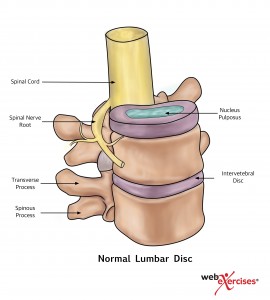
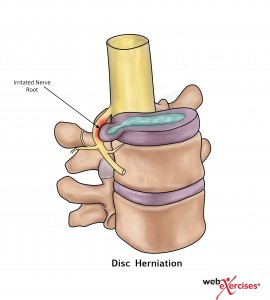
In order to develop appropriate low back stabilization programs, we must first understand some of the reasons people experience back pain. To begin with, altered motor control and deconditioning of the deep spine stabilizer muscles are some theories suggested in today's literature. The recurrence rate of low back pain is most significant in individuals who have suffered at least one episode of low back pain. MacDonald et al. demonstrated a delayed onset of the deep spine multifidus muscle activation in subjects who had a history of LBP (9). This means that the deep spine muscles should activate prior to the actual movement in order to stabilize the spine. Therefore, individuals with a history of low back pain experience this delay in motor control, leaving them vulnerable to injury with activities of daily living.
In another study, Nijis and colleagues showed that pain alters motor control and normal movement resulting in compensation strategies even after the subjects had recovered from their episodic LBP (10). The long term sequelle of these compensation patterns are pathological changes of the multifidus muscle including atrophy, fatty infiltration and weakness in as many as 80% of people with LPB (11).
Considerations for exercise programming to prevent low back pain.
Exercise programming should focuses on stabilizing and strengthening the deep spine and major muscles of and around the low back. One of the larger muscles that is integral to the stability of the spine is the quadratus lumborum as noted by McGill and colleagues. They found this muscle was “best suited to be the major stabilizer of the lumbar spine.” They further stated the “side support” or “side bridge” exercise was identified to optimally challenge the quadratus lumborum and the muscles of the abdominal wall while minimizing lumbar spinal loads (12).
Therefore, based on McGill’s findings, performing an endurance side bridge or side plank is an ideal way to not only improve spine stability but it can also be used to establish a strength baseline with clients. The full side plank position is performed with the top foot placed on top of or in front of the lower foot for support. Instruct clients to lift their hips off the floor to maintain a straight line over their full body length, and support themselves on one elbow and their feet.
The uninvolved arm is held across the chest with the hand placed on the opposite shoulder. The test ends when the hips return to the floor. This exercise and test can also be regressed and performed with the knees bent and contacting the floor when working with deconditioned clients.
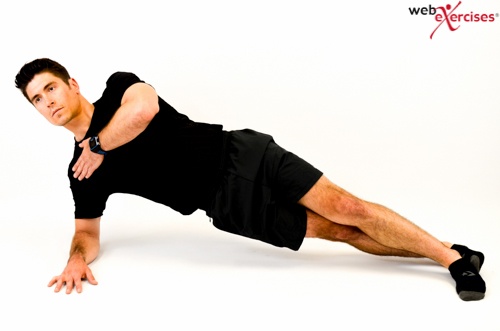 Side bridge
Side bridge
Normal endurance times in the full plank position for healthy men and women with a mean age of 23 years are 90 seconds and 70 seconds respectively (12). Given the relatively young age of the participants in this particular study, shorter endurance times may need to be considered when working with clients with a history of low back pain. If your client experiences pain when performing this maneuver at any point, the test should be stopped immediately.
Now that a strength baseline is established, exercise selection may be established. When working with a population of clients with a history of low back pain, one must consider the type of exercise and its effects on the low back or the “Risk vs Reward” of an exercise. The chart below, adapted from the work of Wilke and colleagues, demonstrates the intradiscal pressure with common exercises and activities (13). Note that standing represents 100% of intradiscal pressure while performing a sit up is more than double.
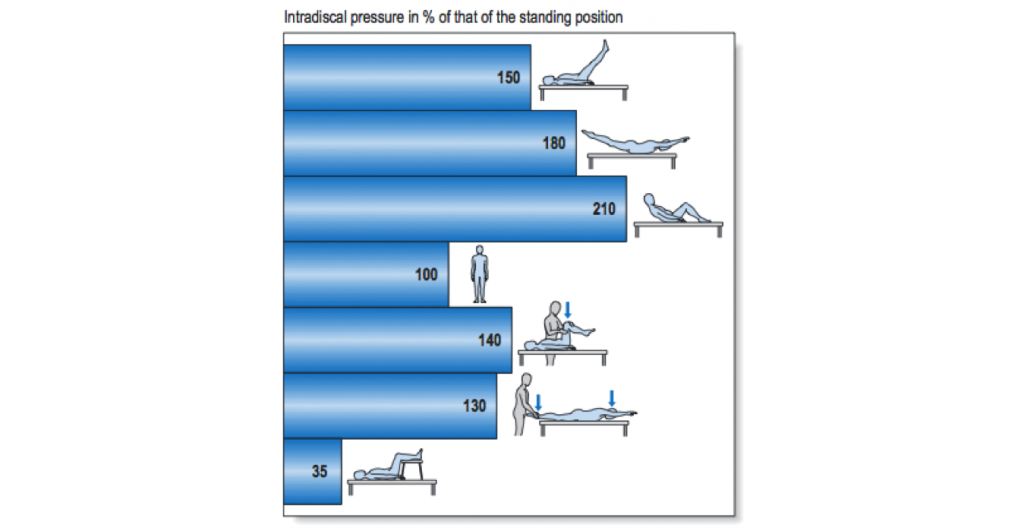
Although the below “Superman” exercise can be beneficial to improve erector spinae strength, it results in 180% of normal intradiscal pressure compared to standing. Therefore the “Risk vs Reward” should be considered when recommending exercises for clients with a history of LBP.

The graph below, adapted from McGill, demonstrates this “Risk vs Reward” concept related to several common exercises. The risk of injury is represented by the red dotted line. Exercises that are above the line represent a higher risk of injury due to the compressive loads on the spine, while the exercises below the line represent sufficient muscular EMG activity for the spinal stabilizers with relatively low spinal loading.
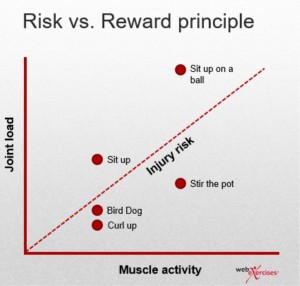
Risk vs Reward Adapted from McGill
As you can see, the Bird Dog and Curl Up have a very similar effect on muscle activity, but the Sit Up has high joint loading (i.e., risk). The same holds true for the exercises Stir the Pot (low risk, high reward) and Sit Up on a Ball (high risk, high reward). When developing generic protocols to prevent low back pain it is safer to focus on integrating exercises that are below the ‘injury risk line’ and are focused on high exercise volume.
Three exercises that provide sufficient spine stability with minimal loading are known as the “Big 3” which are the modified curl up, side plank and quadruped bird dog. Spine stability requires muscles to be co-contracted for durations with relatively low levels of contractions. These exercises are designed for endurance and motor control, not for strength (14).


Bird Dog Exercise - Activate core muscles. Raise one arm to shoulder level as opposite leg simultaneously lifts off floor, extending to hip height. Pause momentarily. Return to start position and alternate sides. Maintain a straight spine position, do not allow hips to twist or rotate. Do not hyper-extend low back when extending leg.


McGill Curl Up - Lift shoulders off floor, trying to maintain a neutral spine position without rounding low back. Do not allow head to move forward of shoulders during movement. Elbows can remain in contact with floor during movement. Pause momentarily. Return to start position.
When performing these and other exercises to improve core stability, abdominal bracing or activation of the abdominal wall musculature is also recommended. These exercises should be performed in a neutral spine position when possible, avoiding pelvic tilting and excessive low back rounding or arching. After clients have demonstrated sufficient strength and motor control, they may be progressed to exercises that involve flexion and extension in order to further strengthen the abdominal and erector spinae musculature (15).


Stir the Pot - Begin kneeling in front of stability ball. Rest elbows on ball. Straighten legs into a plank position. Keeping spine straight, roll elbows in a circular motion on the ball. Perform this movement in 10 second intervals resting 3 seconds between reps.
Considerations for exercise programming to improve low back pain
It is of utmost importance that clients with existing low back pain be cleared by their physician before starting an exercise program. If the client has completed physical therapy, you can use the exercises that they have learned during their sessions as a good starting point and base for progression or refer to the NASM Essentials of Corrective Exercise book for recommendations.
Here are some general guidelines for working with clients with previous or existing low back conditions (16):
- Never exercise through pain.
- Groove appropriate and perfect motion and motor patterns before adding load or other challenges.
- Start by taking gravity out of the equation; start supine or prone, quadruped, kneeling then standing.
- Increase intensity or time, but not both.
- Intensity can be increased by either changing resistance or changing stability.
If the client is ready to be progressed, the following guidelines will help you do this safely and effectively (17):
- If the client is still making progress then continue with the current work load.
- If the client is at plateau then progress at a 2-10% increase.
- If the patient experiences a flare-up then decrease volume.
Some other suggestions to consider when working with clients with a history of LBP are:
- Avoid unsupported forward flexion exercises at first.
- Avoid lifting both legs in a supine or prone position.
- Avoid rapid movements especially twisting at the waist.
- Extend warm-up and cool down periods.
- Focus on good form, training the movement and not the muscles.
As with all exercise programs, long-term adherence and exercise execution on a regular basis are important to achieve satisfying results. After your clients have mastered the movements and are able to maintain good form, you can provide them with short at-home protocols that they can do without equipment to establish regular activity patterns and thus increase their results.
Additional context on lower back pain for clients:
References
- Hoy, D., et al. (2014). The global burden of low back pain: estimates from the Global Burden of Disease 2010 study
- Crow, W., Willis, D. (2009). Estimating cost of care for patients with acute low back pain: a retrospective review of patient records. J Am Osteopath Assoc. Apr;109(4):229-33.
- Loney, P., Stratford, P. (1999).The Prevalence of Low Back Pain in Adults: A Methodological. Review of the Literature. Physical Therapy. Vol 79(4):384-396.
- Hoy, D., et al. 2010. The Epidemiology of low back pain. Best Practice and Research Clinical Rheumatology. 24:769-781.
- Zhang, Y., et al. (2009). Clinical diagnosis for discogenic low back pain. Int. J. Biol. Sci. 5(7):647-658
- Bogduk, N., et al. (2013). Lumbar Discogenic Pain: State-of-the-Art Review. Pain Medicine. 14: 813–836.
- Delitto, A., et al. (2012). Low Back Pain Clinical Practice Guidelines Linked to the International Classification of Functioning, Disability, and Health from the Orthopaedic Section of the American Physical Therapy Association . J Orthop Sports Phys Ther. 42(4).
- Hancock, M., et al. (2007). Systematic review of tests to identify the disc, SIJ or facet joint as the source of low back pain. Eur Spine J. 16:1539–1550.
- MacDonald, D., et al. (2009). Why do some patients keep hurting their back? Evidence of ongoing back muscle dysfunction during remission from recurrent back pain. PAIN 142, 183–188.
- Nijis, J., et al. (2012). Nociception Affects Motor Output, A Review on Sensory-motor Interaction With Focus on Clinical Implications. Clin J Pain Volume 28, Number 2.
- Danneels, L., et al. (2001). Effects of three different training modalities on the cross sectional area of the lumbar multifidus muscle in patients with chronic low back pain. Br J Sports Med 35:186–191.
- McGill, S., et al. (1999). Endurance Times for Low Back Stabilization Exercises: Clinical Targets for Testing and Training From a Normal Database . Arch Phys Med Rehabil Vol 80.
- Wilke, H., el al. (1999). New In Vivo Measurements of Pressures in the Intervertebral Disc in Daily Life. Spine. Vol24, Number 8, pp 755–762.
- McGill, S. (2010). Core Training: Evidence Translating to Better Performance and Injury Prevention. Strength and Conditioning Journal. Vol 32(3).
- Akuthota, V., et al. (2008). Core Stability Exercise Principles. Curr. Sports Med. Rep., Vol. 7(1) 39-44.
- Adapted from Blog by Ed LeCara, PhD, DC, MBA, ATC, CSCS
- Med Sci Sports Exerc. (2009). American College of Sports Medicine position stand. Progression models in resistance training for healthy adults. Mar;41(3):687-708.
















